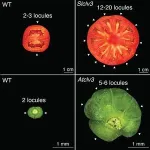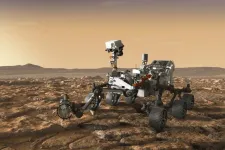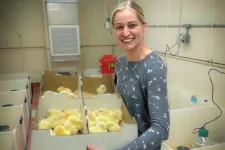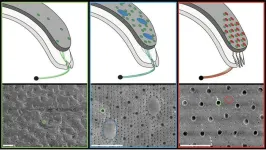(Press-News.org) UNIVERSITY PARK, Pa. — Fat tissue holds the key to 3D printing layered living skin and potentially hair follicles, according to researchers who recently harnessed fat cells and supporting structures from clinically procured human tissue to precisely correct injuries in rats. The advancement could have implications for reconstructive facial surgery and even hair growth treatments for humans.
The team’s findings published today (March 1) in Bioactive Materials. The U.S. Patent and Trademark Office granted the team a patent in February for the bioprinting technology it developed and used in this study.
“Reconstructive surgery to correct trauma to the face or head from injury or disease is usually imperfect, resulting in scarring or permanent hair loss,” said Ibrahim T. Ozbolat, professor of engineering science and mechanics, of biomedical engineering and of neurosurgery at Penn State, who led the international collaboration that conducted the work. “With this work, we demonstrate bioprinted, full thickness skin with the potential to grow hair in rats. That’s a step closer to being able to achieve more natural-looking and aesthetically pleasing head and face reconstruction in humans.”
While scientists have previously 3D bioprinted thin layers of skin, Ozbolat and his team are the first to intraoperatively print a full, living system of multiple skin layers, including the bottom-most layer or hypodermis. Intraoperatively refers to the ability to print the tissue during surgery, meaning the approach may be used to more immediately and seamlessly repair damaged skin, the researchers said. The top layer — the epidermis that serves as visible skin — forms with support from the middle layer on its own, so it doesn’t require printing. The hypodermis, made of connective tissue and fat, provides structure and support over the skull.
“The hypodermis is directly involved in the process by which stem cells become fat,” Ozbolat said. “This process is critical to several vital processes, including wound-healing. It also has a role in hair follicle cycling, specifically in facilitating hair growth.”
The researchers started with human adipose, or fat, tissue obtained from patients undergoing surgery at Penn State Health Milton S. Hershey Medical Center. Collaborator Dino J. Ravnic, associate professor of surgery in the Division of Plastic Surgery at Penn State College of Medicine, led his lab in obtaining the fat for extraction of the extracellular matrix — the network of molecules and proteins that provides structure and stability to the tissue — to make one component of the bioink.
Ravnic’s team also obtained stem cells, which have the potential to mature into several different cell types if provided the correct environment, from the adipose tissue to make another bioink component. Each component was loaded into one of three compartments in the bioprinter. The third compartment was filled with a clotting solution that helps the other components properly bind onto the injured site.
“The three compartments allow us to co-print the matrix-fibrinogen mixture along with the stem cells with precise control,” Ozbolat said. “We printed directly into the injury site with the target of forming the hypodermis, which helps with wound healing, hair follicle generation, temperature regulation and more.”
They achieved both the hypodermis and dermis layers, with the epidermis forming within two weeks by itself.
“We conducted three sets of studies in rats to better understand the role of the adipose matrix, and we found the co-delivery of the matrix and stem cells was crucial to hypodermal formation,” Ozbolat said. “It doesn’t work effectively with just the cells or just the matrix — it has to be at the same time.”
They also found that the hypodermis contained downgrowths, the initial stage of early hair follicle formation. According to the researchers, while fat cells do not directly contribute to the cellular structure of hair follicles, they are involved in their regulation and maintenance.
“In our experiments, the fat cells may have altered the extracellular matrix to be more supportive for downgrowth formation,” Ozbolat said. “We are working to advance this, to mature the hair follicles with controlled density, directionality and growth.”
According to Ozbolat, the ability to precisely grow hair in injured or diseased sites of trauma can limit how natural reconstructive surgery may appear. He said that this work offers a “hopeful path forward,” especially in combination with other projects from his lab involving printing bone and investigating how to match pigmentation across a range of skin tones.
“We believe this could be applied in dermatology, hair transplants, and plastic and reconstructive surgeries — it could result in a far more aesthetic outcome,” Ozbolat said.
“With the fully automated bioprinting ability and compatible materials at the clinical grade, this technology may have a significant impact on the clinical translation of precisely reconstructed skin.”
Ravnic and Ozbolat also are affiliated with the Huck Institutes of the Life Sciences and the Penn State Cancer Institute. Ozbolat has additional affiliations with the Penn State Materials Research Institute and the Department of Medical Oncology at Cukurova University in Turkey, where he is currently on sabbatical leave. Other contributors include Yogendra Pratap Singh, postdoctoral scholar, and Mecit Altan Alioglu, graduate student, both in the Penn State Department of Engineering Science and Mechanics; Youngnam Kang and Miji Yeo, both researchers, and Irem Deniz Derman, graduate student, in the Huck Institutes of the Life Sciences; Yang Wu, Harbin Institute of Technology in China; and Jasson Makkar and Ryan R. Driskell, College of Veterinary Medicine at Washington State University. Kang, Yeo, Singh, Alioglu and Derman also are affiliated with Penn State Department of Engineering Science and Mechanics.
The National Institutes of Health and the Scientific and Technological Research Council of Türkiye supported this work.
END
3D-printed skin closes wounds and contains hair follicle precursors
Bioengineered advancement may have implications for more natural-looking reconstructive surgery outcomes, according to international research team
2024-03-04
ELSE PRESS RELEASES FROM THIS DATE:
Discovered a RNA molecule that helps prevent DNA replication errors
2024-03-04
Researchers at Cima Universidad de Navarra have discovered that a ribonucleic acid that does not contain information to make proteins (long non-coding RNA) plays a crucial role in signalling and repairing errors in DNA replication during cell division. This finding could lead to the development of new anti-tumour therapies.
Scientists have identified an RNA that they named 'lncREST' (long non-coding RNA REplication STress) and uncovered its role in triggering an effective response to the stress induced by rapid cell division. "LncREST localises ...
Small and overlooked: Amount of repetitive DNA in blood hints at cancer early
2024-03-04
FOR IMMEDIATE RELEASE
People with cancer have different amounts of a type of repetitive DNA — called Alu elements — than people without cancer. Now, machine learning can measure that from a blood draw. Researchers at the Johns Hopkins Kimmel Cancer Center have used this finding to improve a test that detects cancer early, validating and reproducing the results by starting with a sample size tenfold larger than typical of such types of studies.
The research was published Jan. 24 in the journal Science Translational Medicine.
Alu ...
Study determines the original orientations of rocks drilled on Mars
2024-03-04
As it trundles around an ancient lakebed on Mars, NASA’s Perseverance rover is assembling a one-of-a-kind rock collection. The car-sized explorer is methodically drilling into the Red Planet’s surface and pulling out cores of bedrock that it’s storing in sturdy titanium tubes. Scientists hope to one day return the tubes to Earth and analyze their contents for traces of embedded microbial life.
Since it touched down on the surface of Mars in 2021, the rover has filled 20 of its 43 tubes with cores of bedrock. Now, MIT geologists have remotely determined a crucial property of the rocks collected to date, which will help scientists answer key questions about the planet’s ...
Illinois study: Supporting disease-challenged broiler chickens through nutrition
2024-03-04
URBANA, Ill. — When broiler chickens are busy fighting the parasitic infection coccidiosis, they can’t absorb nutrients efficiently or put energy toward growth. With consumer sentiment pitted against antimicrobials and other drugs, producers still have some options to ensure optimal growth during inevitable outbreaks. New research from the University of Illinois Urbana-Champaign suggests diet changes might help.
“Vaccines and anticoccidials are the traditional ways to prevent this disease. Nutrition can't replace all of the pharmaceuticals, but it can be supportive in providing care,” said senior study author Ryan Dilger, ...
Communities severed by roads and traffic experience a larger number of collisions in New York City
2024-03-04
March 4, 2024- New York City neighborhoods with disrupted community connections, due to traffic, roads, and transport infrastructure, are experiencing an increase in traffic collisions. This increase is seen both in total collisions and for those in which pedestrians or cyclists are injured or killed, according to a new study from Columbia University Mailman School of Public Health. The findings are reported in the journal Environment International.
“Despite recent remarkable progress, road safety remains an urgent urban issue in New York and other U.S. cities. It is important to understand how the spatial configuration of the city enhances ...
Study shows new class of antivirals that works against SARS-CoV-2
2024-03-04
EDMONTON — A University of Alberta research team has uncovered a new class of drugs with the potential to prevent or treat infections in a future viral outbreak.
In the paper, published this week in Nature, the team reports that SARS-CoV-2 — the virus that causes COVID-19 — activates a pathway in cells that stops the production of peroxisomes and interferon, key parts of the normal immune response. The team successfully tested a new class of antiviral drugs that stimulate interferon production to reverse that effect.
Tom ...
Cost of direct air carbon capture to remain higher than hoped
2024-03-04
Switzerland plans to reduce its net carbon emissions to zero by no later than 2050. To achieve this, it will need to drastically reduce its greenhouse gas emissions. In its climate strategy, the Swiss government acknowledges that some of these emissions, particularly in agriculture and industry, are difficult or impossible to avoid. Swiss climate policy therefore envisages actively removing 5 million tonnes of CO2 from the air and permanently storing it underground. By way of comparison, the Intergovernmental ...
Unraveling the mystery of chiton visual systems
2024-03-04
(Santa Barbara, Calif.) — You’d probably walk past a chiton without even seeing it. These creatures often look like nothing more than another speck of seaweed on the crusty intertidal rocks. But it sees you. At least, if it’s one of the species with eyes dotting its platemail shell.
A team of scientists — led by Rebecca Varney at UC Santa Barbara’s Department of Ecology, Evolution, and Marine Biology (EEMB) — discovered that some of these tough mollusks sport the most recently evolved eyes with a lens. What’s more, the ...
Case Western Reserve University-led research team discovers new method to test for oral cancer
2024-03-04
CLEVELAND—Oral cancers and precancerous mouth lesions are considered especially difficult to diagnose early and accurately.
For one, biopsies are expensive, invasive, stressful for the patient and can lead to complications. They’re also not feasible if repeated screenings of the same lesion are required.
But a team of researchers, led by a clinician scientist at the Case Western Reserve University School of Dental Medicine, has discovered a noninvasive, low-cost test to detect oral cancer, monitor precancerous lesions and determine when a biopsy is warranted.
Their findings, published ...
Firearm access and gun violence exposure are common in Black and native communities
2024-03-04
A New Jersey Gun Violence Research Center study is the first to provide nationally representative data on gun use, storage and violence within Black and American Indian/Alaskan Native (AIAN) families.
Both Black and native communities have seen increasingly elevated rates of gun violence victimization, including homicide and suicide, according to the Centers for Disease Control and Prevention. In recent years, minorities have become more represented among new firearm owners. Despite this, research on firearm access, storage and use has focused on samples of white adults. This prevents understanding the access Black and native individuals have to firearms, whether they are stored ...
LAST 30 PRESS RELEASES:
Stardust study resets how life’s atoms spread through space
Practical education: Clinical scenario-based program development
The impact of family dynamics on eating behaviour – how going home for Christmas can change how you eat
Tracing the quick synthesis of an industrially important catalyst
New software sheds light on cancer’s hidden genetic networks
UT Health San Antonio awarded $3 million in CPRIT grants to bolster cancer research and prevention efforts in South Texas
Third symposium spotlights global challenge of new contaminants in China’s fight against pollution
From straw to soil harmony: International team reveals how biochar supercharges carbon-smart farming
Myeloma: How AI is redrawing the map of cancer care
Manhattan E. Charurat, Ph.D., MHS invested as the Homer and Martha Gudelsky Distinguished Professor in Medicine at the University of Maryland School of Medicine
Insilico Medicine’s Pharma.AI Q4 Winter Launch Recap: Revolutionizing drug discovery with cutting-edge AI innovations, accelerating the path to pharmaceutical superintelligence
Nanoplastics have diet-dependent impacts on digestive system health
Brain neuron death occurs throughout life and increases with age, a natural human protein drug may halt neuron death in Alzheimer’s disease
SPIE and CLP announce the recipients of the 2025 Advanced Photonics Young Innovator Award
Lessons from the Caldor Fire’s Christmas Valley ‘Miracle’
Ant societies rose by trading individual protection for collective power
Research reveals how ancient viral DNA shapes early embryonic development
A molecular gatekeeper that controls protein synthesis
New ‘cloaking device’ concept to shield sensitive tech from magnetic fields
Researchers show impact of mountain building and climate change on alpine biodiversity
Study models the transition from Neanderthals to modern humans in Europe
University of Phoenix College of Doctoral Studies releases white paper on AI-driven skilling to reduce burnout and restore worker autonomy
AIs fail at the game of visual “telephone”
The levers for a sustainable food system
Potential changes in US homelessness by ending federal support for housing first programs
Vulnerability of large language models to prompt injection when providing medical advice
Researchers develop new system for high-energy-density, long-life, multi-electron transfer bromine-based flow batteries
Ending federal support for housing first programs could increase U.S. homelessness by 5% in one year, new JAMA study finds
New research uncovers molecular ‘safety switch’ shielding cancers from immune attack
Bacteria resisting viral infection can still sink carbon to ocean floor
[Press-News.org] 3D-printed skin closes wounds and contains hair follicle precursorsBioengineered advancement may have implications for more natural-looking reconstructive surgery outcomes, according to international research team







